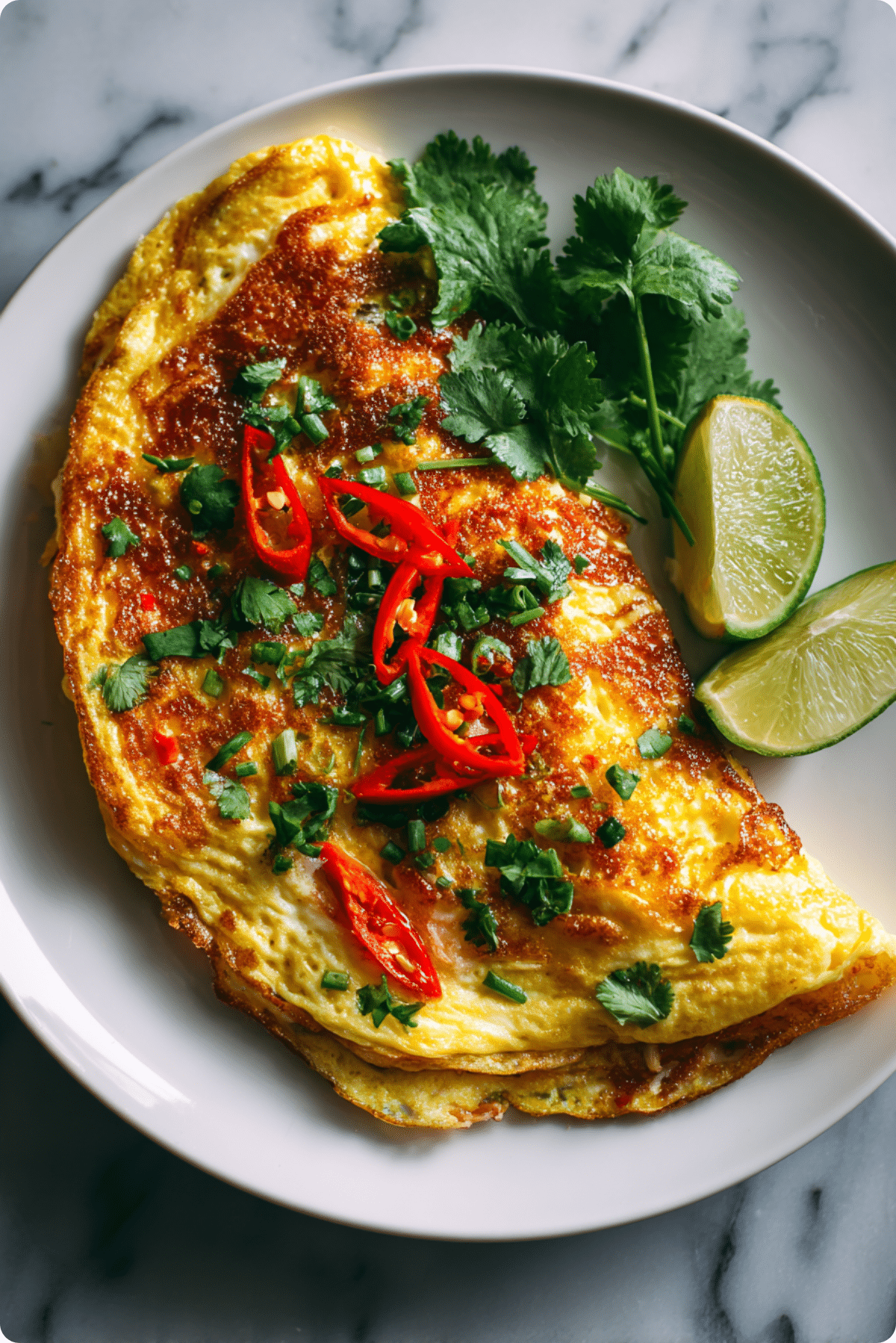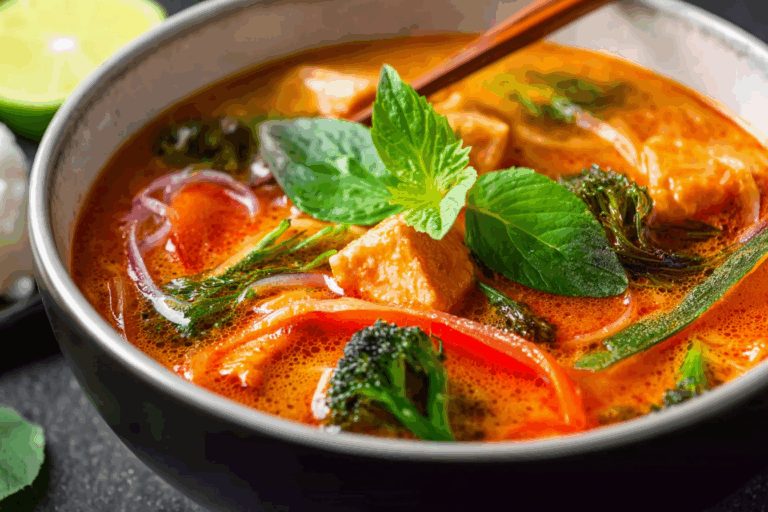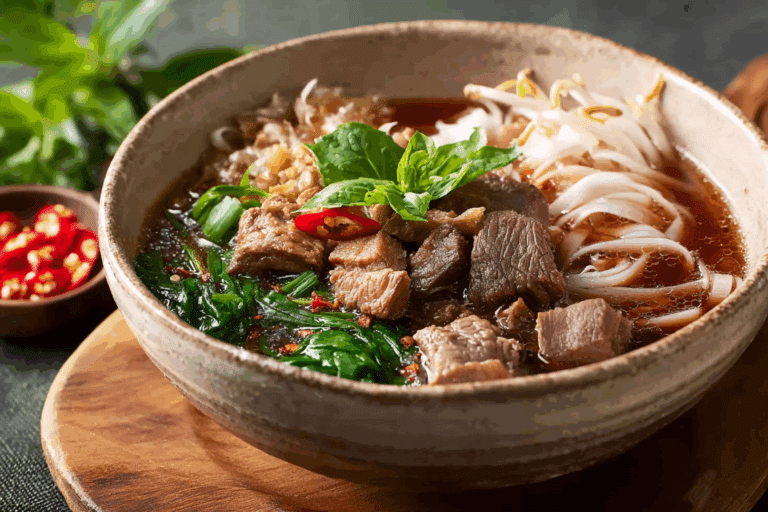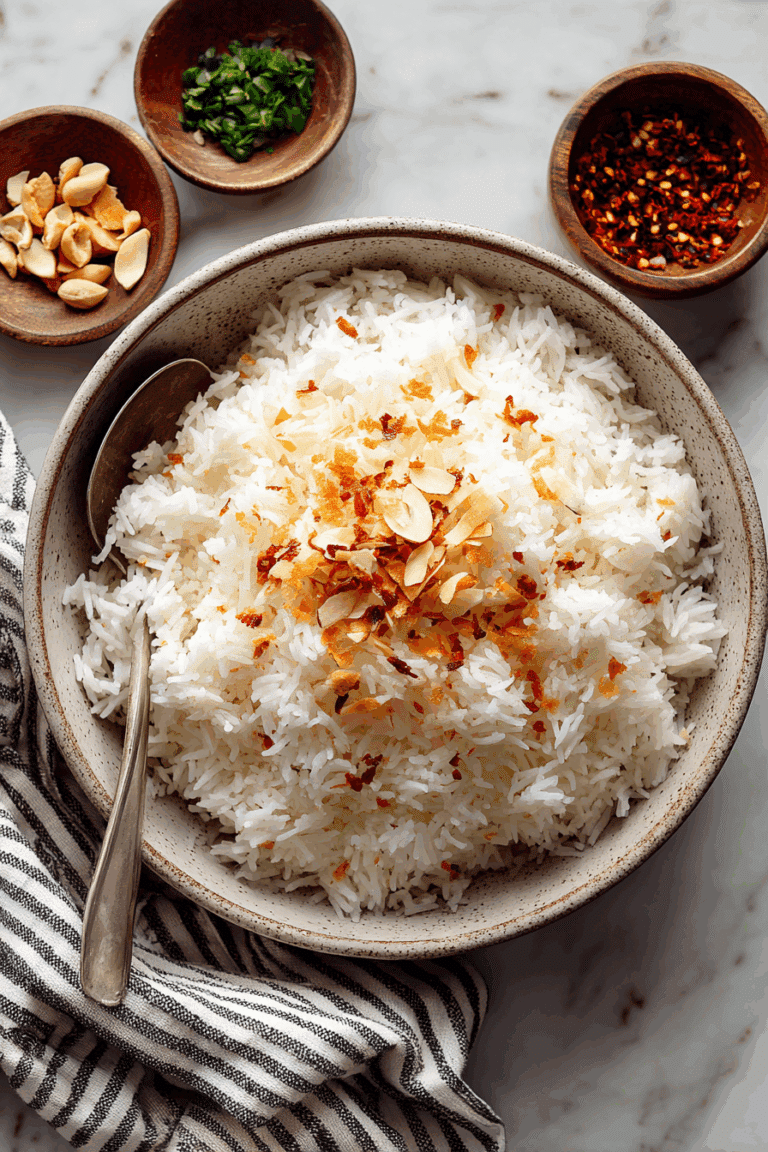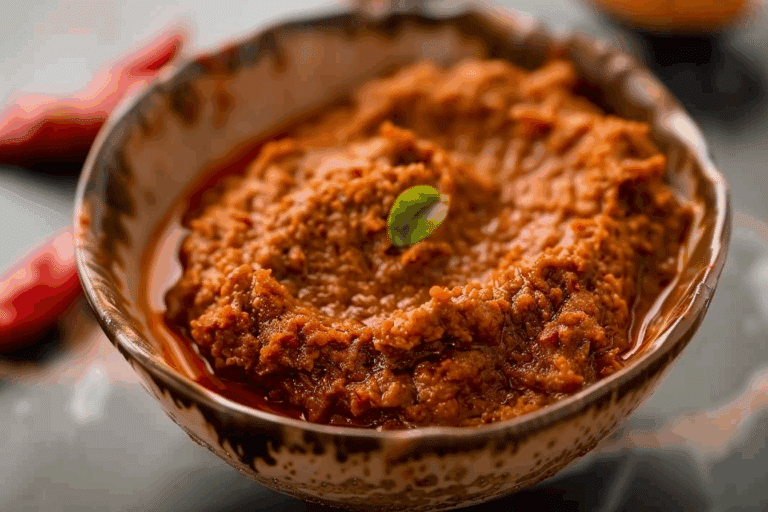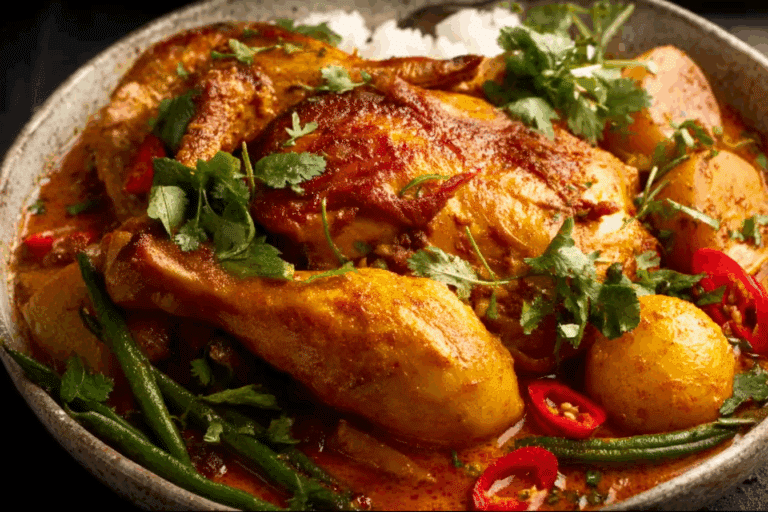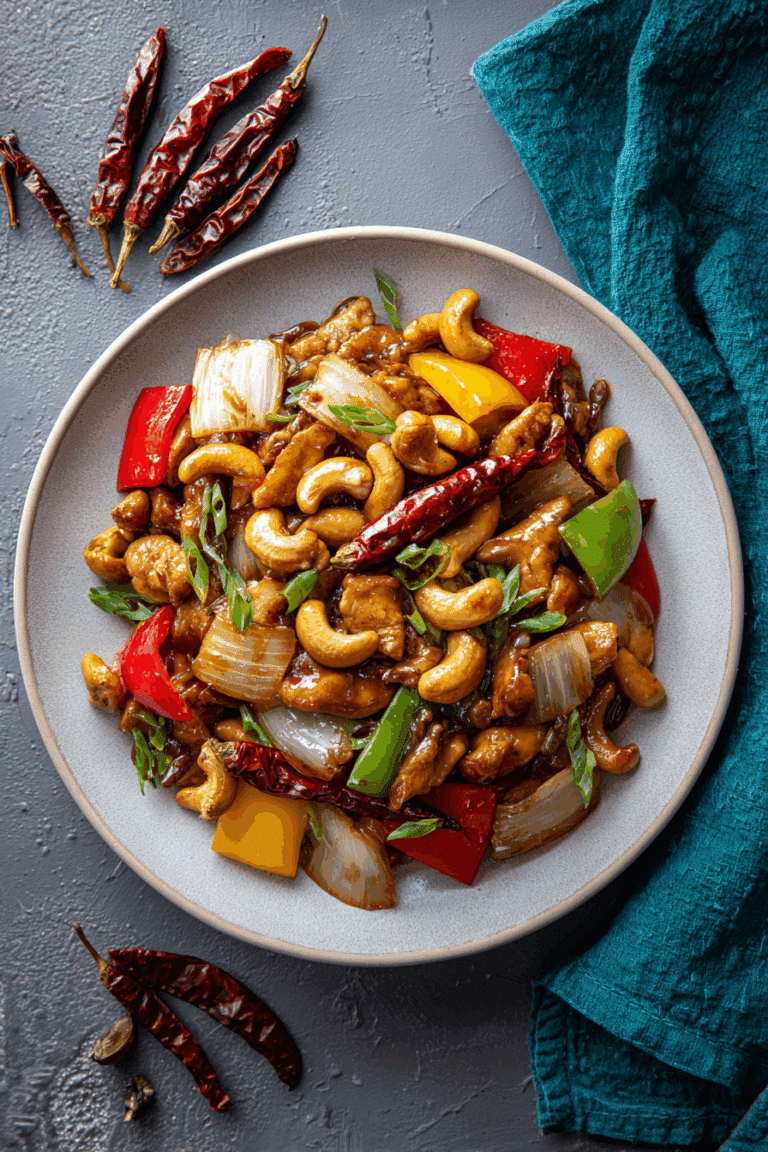How to Make Thai Crab Omelette Recipe That’s Truly Special
Thai Crab Omelette Recipe is one of those dishes that captures everything I love about Thai food, which is warmth, simplicity, and bold flavor. When I started Just Thai Recipes, I wanted to share recipes that reflect the heart of home cooking in Thailand. On my About Page, I tell the story of how this passion began in my grandmother’s small kitchen in Bangkok, where the scent of sizzling oil, fresh herbs, and golden crab omelette filled the air every morning. It was the sound of breakfast and comfort, something that always made me smile.
This Thai Crab Omelette Recipe is inspired by those childhood memories, but also by the famous Bangkok street stalls where this humble dish has become a superstar. The most well-known version comes from Jay Fai, the Michelin-starred Thai chef who made this crab omelette world-famous. Her version is rich, golden, and fluffy, packed with crab meat that melts in your mouth. But the beauty of Thai cooking is that you can create the same delicious results at home with just a few simple ingredients and the right technique.
If you’ve ever tried a traditional Thai crab omelette recipe on the streets of Bangkok, you’ll remember how light yet flavorful it is, crispy on the outside and soft in the center. That perfect texture comes from whisking the eggs with care and frying them in very hot oil, which creates airy layers that puff beautifully. What I love most is how fast it comes together, making it perfect for both busy mornings and elegant dinners.
In this post, you’ll not only learn how to make the Thai Crab Omelette Recipe at home, but you’ll also discover a few secrets to getting that perfect golden crisp, just like the street vendors in Thailand. I’ll also share some ideas for variations, tips, and the health benefits of crab meat and eggs. Whether you want a simple Thai crab omelette recipe or something closer to the Jay Fai version, this guide will help you master it step by step.
Making this dish connects me back to my roots. Every time I crack those eggs and hear them sizzling in the pan, I remember why I started cooking in the first place. So, get your wok ready, take a deep breath, and let’s dive into how to make this amazing Thai Crab Omelette Recipe that tastes just like Bangkok in your kitchen.
Table of Contents
Table of Contents
Ingredients
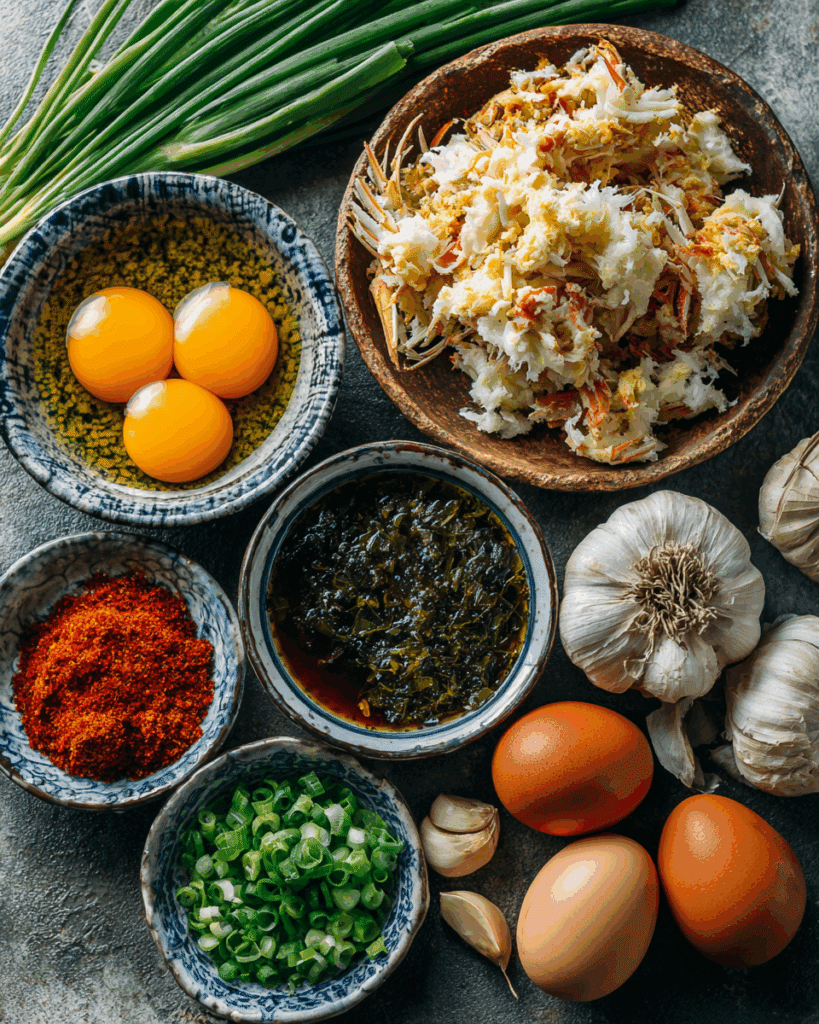
The ingredients for this Thai Crab Omelette Recipe are simple, yet each one plays a key role in building that rich, balanced flavor. You’ll only need a handful of things, but it’s important to choose quality ingredients because this dish doesn’t rely on heavy spices or sauces. It’s all about freshness and technique.
Here’s what you’ll need to make one perfect omelette:
- 3 eggs – Use fresh, large eggs for the best texture. Eggs are the base of this recipe, and they create that soft, airy structure that holds the crab meat.
- 1 cup crab meat – The star of the show. You can use fresh or canned crab meat, but if you have access to lump crab, that’s ideal for flavor and texture. It’s what gives this Thai Crab Omelette Recipe its signature sweetness and richness.
- ½ tablespoon Golden Mountain Sauce – This Thai seasoning sauce adds umami and saltiness. It’s similar to soy sauce but with a deeper, slightly sweeter flavor. If you can’t find it, a mix of soy sauce and a drop of fish sauce will work.
- 1 clove garlic, minced – A little garlic brings aroma and enhances the flavor of the crab and eggs.
- Oil for deep-frying, as needed – Traditional Thai omelettes are fried in enough oil to float the mixture slightly, giving that crisp, puffy edge. Use a neutral oil like canola or sunflower oil.
- 1 tablespoon coriander (optional), chopped, for topping – Adds freshness and a nice color contrast.
- 1 green onion (optional), chopped, for topping – A sprinkle of green onions gives brightness and a bit of crunch.
Ingredient Notes and Swaps
If you want to make a simple Thai crab omelette recipe but don’t have crab, you can substitute shrimp or even canned tuna, although the flavor will be slightly different. For a lighter version, reduce the oil and cook it like a French-style crab omelette, but the texture will be less crispy.
You can also add a small splash of sparkling water when whisking the eggs. This is a trick some Thai chefs use to make the omelette extra fluffy. Another secret is to beat the eggs longer than you think really whip air into them so they expand beautifully once they hit the hot oil.
Some people like to add a dash of white pepper or a few drops of lime juice for a touch of brightness. Personally, I prefer to keep it classic and let the crab’s natural sweetness shine through.
When you make this Thai Crab Omelette Recipe, think of it as an opportunity to connect with a culinary tradition that goes back generations. It’s a dish that doesn’t need fancy tools or expensive ingredients, just attention and love.
Step-by-Step Instructions
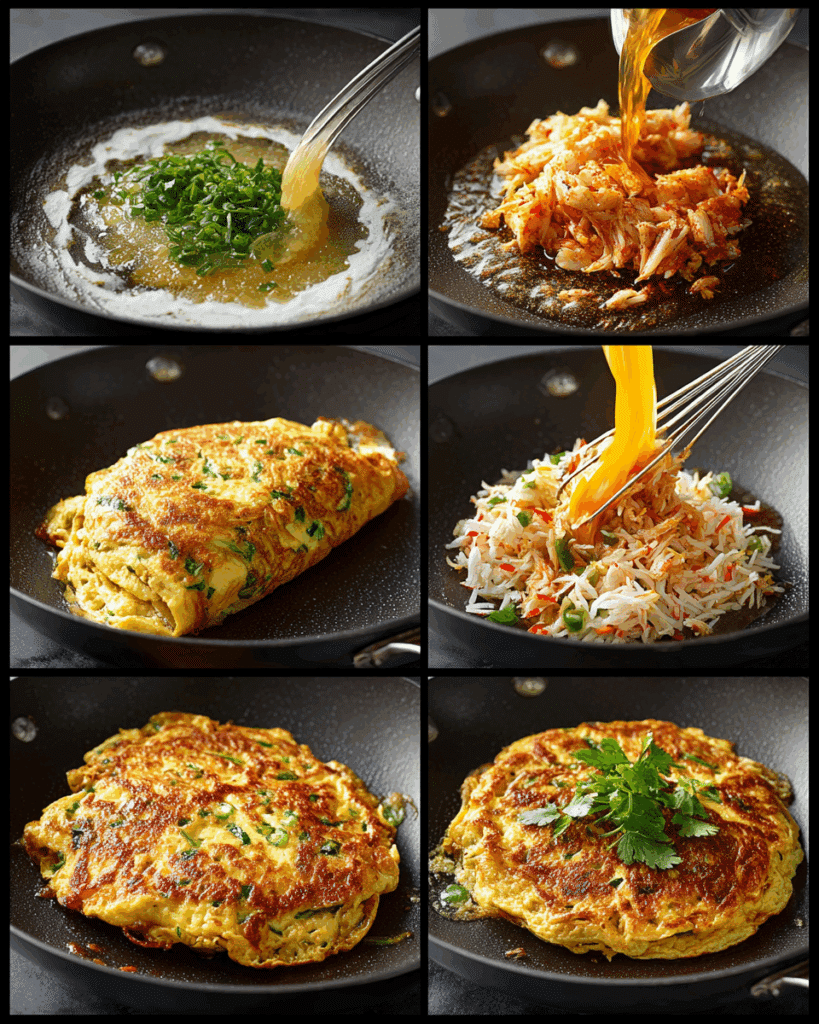
Making the Thai Crab Omelette Recipe is not difficult, but like most traditional Thai dishes, the magic is in the small details. Each step matters, from how you beat the eggs to the way you pour the mixture into the oil. Take your time, and you’ll get a crisp, golden omelette that tastes like it came straight from a Bangkok street vendor.
Let’s go through it carefully.
Step 1: Beat the Eggs Properly
Crack three fresh eggs into a medium-sized bowl. Add the Golden Mountain Sauce right away, which gives the eggs a slightly savory flavor. Use a fork or chopsticks to whisk them vigorously for about one to two minutes. The goal is to create bubbles and get the mixture airy. You want to incorporate air into the eggs because this is what helps the Thai Crab Omelette Recipe puff beautifully once it hits the hot oil. Don’t just stir the eggs lightly, you should really beat them until they look frothy and pale yellow.
Step 2: Add the Crab and Garlic
Now that the eggs are ready, gently add the crab meat and the minced garlic. Mix slowly so you don’t break the crab chunks. One of the best things about the Thai Crab Omelette Recipe is the soft texture of the crab meat inside the fluffy omelette, so you want to keep those pieces whole. The garlic adds a wonderful aroma that fills your kitchen the moment it hits the hot oil.
Step 3: Heat the Oil Correctly
This part is essential. Heat a generous amount of oil in a deep, non-stick pan or wok. The oil should be about one to one and a half inches deep. You want enough oil so that the egg mixture can float. The oil temperature should be around 350°F (175°C). To check, drop a small bit of egg into the pan. If it sizzles and rises to the top immediately, your oil is ready. This step defines the crispiness of your Thai Crab Omelette Recipe.
Step 4: Pour and Fry
Once the oil is hot, slowly pour the egg and crab mixture into the center of the pan. Don’t move it around right away. Let it bubble and rise naturally. The outside will start to crisp while the inside stays soft. If you want a Bangkok-style rolled omelette, wait about twenty seconds, then use a spatula to gently fold one edge over toward the center, then another layer, repeating until you form a thick roll. Continue frying, turning carefully so it cooks evenly. If you prefer the simple version, just fry the omelette as one whole piece, flipping once when golden on the bottom.
Step 5: Drain and Serve
Once it’s golden brown and crisp on both sides, carefully lift it from the oil and place it on a paper towel to drain. This helps remove excess oil and keeps the omelette light. Garnish with freshly chopped coriander and green onions. Serve hot with steamed jasmine rice, chili sauce, and maybe a wedge of lime for brightness.
You’ll notice how fragrant and inviting the aroma is, a mix of fried egg, garlic, and sweet crab meat. This is the exact smell that fills Thai morning markets, where vendors cook up hundreds of these omelettes every day.
Tips and Tricks
Cooking a Thai Crab Omelette Recipe perfectly takes a few attempts, but these tips will help you master it faster. Many of these come directly from Thai chefs I’ve met over the years, who shared their tricks for getting that iconic crispy edge and soft center.
Tip 1: Use the Right Pan and Oil Depth
A wok is ideal because of its curved shape, which allows the oil to pool in the center. This helps the omelette float as it cooks, giving that airy, puffed texture. If you don’t have a wok, use a deep skillet instead. Make sure the oil is deep enough for the omelette to fry evenly. Too little oil, and it will turn greasy rather than crisp.
Tip 2: Don’t Overcrowd the Pan
If you double the recipe or make multiple omelettes, cook them one at a time. Overcrowding cools the oil and prevents that instant puffing effect which makes the Thai Crab Omelette Recipe special. Hot oil is your best friend here.
Tip 3: Whisk Until Frothy
Beating the eggs properly is the secret behind the lightness of this dish. You should whisk until the mixture is filled with small bubbles. That air is what lifts the omelette when it hits the oil, creating the famous crispy edges and fluffy interior.
Tip 4: Timing and Temperature Matter
Cooking too long will make the omelette hard and dry, while undercooking will make it soggy. Aim for about one to two minutes per side, depending on the heat. Always test a little drop of egg to make sure your oil is ready before frying the full batch.
Tip 5: Adjust the Sauce to Taste
Golden Mountain Sauce adds saltiness and depth, but every brand can vary. Taste your mixture before frying. If you like it saltier, add a splash more sauce or a drop of fish sauce. For a slightly richer flavor, a small pinch of sugar can balance the taste perfectly.
Tip 6: Keep the Crab Chunks Intact
One of the best parts of the Thai Crab Omelette Recipe is biting into a big piece of sweet crab. So, handle the crab meat gently. Don’t stir it too much when combining with the eggs.
If you want to see a professional Thai chef make it step by step, you can check out some great resources like Thai Foodie’s guide on Thai Crab Omelette or this amazing breakdown from Hungry in Thailand. Both show the same cooking process I’ve shared here, and they highlight how this dish has evolved from humble street food to a Michelin-starred classic.
Tip 7: Serve Immediately
Thai Crab Omelette is best eaten right after cooking. Once it cools down, it can lose some of that crispiness. If you’re cooking for guests, plan to make it just before serving so they can enjoy the full experience.
Tip 8: Make It a Complete Meal
Serve your omelette with warm jasmine rice, Thai chili dipping sauce, and a light vegetable soup on the side. This combination balances the richness of the egg and crab perfectly.
Tip 9: Practice Makes Perfect
Don’t worry if your first omelette isn’t perfect. Even street vendors took years to master that signature crispness. Each time you cook, you’ll get better at judging the oil temperature and timing.
By following these steps and tips, you’ll soon be able to create a restaurant-quality Thai Crab Omelette Recipe in your own kitchen.
Variations
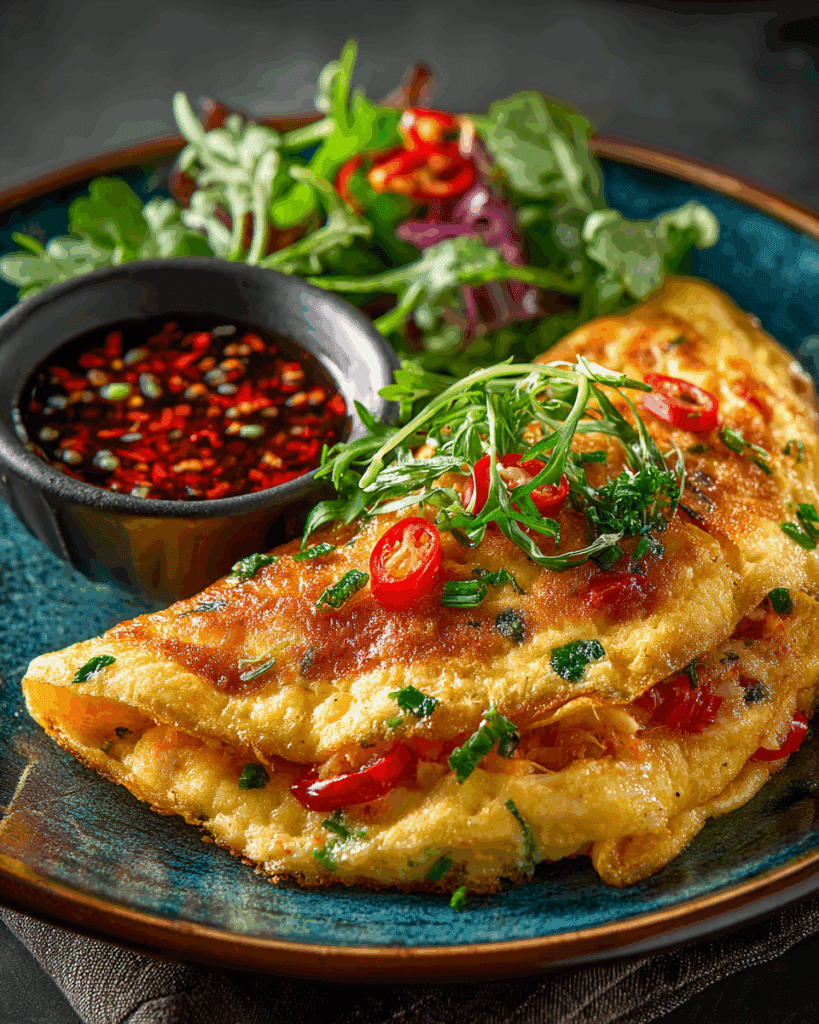
One of the most beautiful things about a Thai Crab Omelette Recipe is how flexible it is. The basic version of the Thai Crab Omelette Recipe uses eggs, fresh crab meat, Golden Mountain Sauce, and hot oil to create that fluffy and crispy texture that everyone loves. But once you understand the base technique of the Thai Crab Omelette Recipe, you can start to shape it into different styles to match your mood, your ingredients, or even your skill level.
This is also where we can talk about some common searches like traditional Thai crab omelette recipe, Thai crab omelette Jay Fai recipe, Thai crab omelette recipe easy, simple Thai crab omelette recipe, and authentic Thai crab omelette recipe, because all of those are just slightly different takes on the same core idea. I will walk you through several versions of the Thai Crab Omelette Recipe so you can choose the one that fits your table today.
The first variation is the traditional Thai Crab Omelette Recipe. This approach focuses on purity and simplicity. You whisk three eggs with Golden Mountain Sauce, mix in chunks of crab meat, and then deep fry the omelette in very hot oil until it puffs up and becomes golden on the outside. The Thai Crab Omelette Recipe in its traditional form is usually served with steamed jasmine rice and prik nam pla, which is a simple fish sauce and chili dip.
This kind of traditional Thai Crab Omelette Recipe is salty, sweet, slightly garlicky, and very comforting. It tastes like home style food, not restaurant food, and that is why people love it. If you want the true taste of Bangkok, you will like this style of Thai Crab Omelette Recipe.
The second version is the Thai crab omelette Jay Fai recipe style. Jay Fai is a famous street food cook in Bangkok who earned a Michelin Star for her crab omelette, which means this version of the Thai Crab Omelette Recipe is extremely rich, packed with extra crab, and shaped in a thicker roll. Her style of Thai Crab Omelette Recipe uses so much crab meat that every single bite feels decadent, almost like eating pure crab wrapped in egg.
The omelette is rolled tightly in the pan using a spatula, then deep fried in very hot oil. This Thai Crab Omelette Recipe is not really budget friendly, since it uses a lot of premium crab, but it is the version that made the Thai Crab Omelette Recipe famous around the world. If you are going for a special dinner, or you want to impress someone, this is the Thai Crab Omelette Recipe that will blow them away.
The third version is what many people search for as Thai crab omelette recipe easy or simple Thai crab omelette recipe. This version of the Thai Crab Omelette Recipe is more friendly for beginners and home cooks. Instead of deep frying the omelette in a large amount of oil, you use a non stick skillet with just enough oil to cover the bottom of the pan. You pour in the egg and crab mixture and let it cook like a thick pancake.
You flip it once, let it cook through, and serve. This easier Thai Crab Omelette Recipe does not puff quite as dramatically, and it will not be as crispy on the outside, but it is faster, cheaper, and less intimidating if you are new to frying. It is also better for people who are trying to cut back on frying oil but still want the flavor of a Thai Crab Omelette Recipe at home.
The fourth version is the authentic Thai Crab Omelette Recipe with fresh herbs. In this style, you sprinkle chopped coriander and chopped green onion into the egg mixture before frying. The result is a Thai Crab Omelette Recipe that tastes brighter and has a little freshness to balance the richness of the crab and egg. Some Thai home cooks also add white pepper to this authentic Thai Crab Omelette Recipe, which gives it a gentle warmth. If you like a lighter, aromatic taste, this version of the Thai Crab Omelette Recipe is perfect, especially for lunch.
Another fun twist is the Thai Crab Omelette Recipe with chili. With this version, you slice fresh Thai chilies, or use a small spoon of chili paste, and mix it into the eggs. It gives the Thai Crab Omelette Recipe a spicy edge which goes really well with the natural sweetness of crab meat. You get heat, salt, and sweet all in one bite, which is exactly what Thai cooking is known for. If you like spicy food, you should try this Thai Crab Omelette Recipe style at least once.
You can also lean into a more Chinese influenced crab meat omelette Chinese recipe. This style still feels related to the Thai Crab Omelette Recipe, but it focuses more on a softer, silkier interior. Sometimes a little cornstarch slurry or a little stock is added to the egg mixture, and it is often cooked with less oil and a gentler heat.
You get a smooth texture and a savory crab and egg flavor that reminds many people of Cantonese style comfort dishes. It is interesting to taste how the crab omelette changes personality depending on how it is cooked. You can serve this softer, Chinese inspired version of a Thai Crab Omelette Recipe over hot white rice or even spoon it over stir fried greens.
A more European sounding twist would be a French crab omelette. A French crab omelette is not quite the same as a Thai Crab Omelette Recipe, because the French style is usually very soft and gently folded, not crispy or puffy. Butter is used instead of high heat frying oil. The flavor is more delicate and mild.
But the idea is still similar, which is egg and crab coming together in a warm, silky bite. You can think of it like two cultures meeting on a plate. The Thai Crab Omelette Recipe gives you bubbly edges and bold savory notes, and the French crab omelette gives you a creamy texture and a softer finish. Both are delicious, and both are worth trying on different days.
Now let us talk about presentation. The traditional Thai Crab Omelette Recipe is often served either rolled tightly like a fat log, or just as a golden pillow with slightly crinkled edges. The Thai crab omelette Michelin Star style, inspired by Jay Fai, is rolled and cut into thick slices before serving, almost like a crab filled omelette steak.
The simple Thai crab omelette recipe for home cooks is more rustic. You just fry it, drain it, and eat it right away with rice and chili sauce. All of these are still the Thai Crab Omelette Recipe, and you can choose which one fits your kitchen and your taste. That is the beauty of cooking. You start with one Thai Crab Omelette Recipe, and by adjusting the oil level, the folding, and the crab amount, you can make totally different results.
When you experiment with variation after variation of a Thai Crab Omelette Recipe, you start to understand why people become obsessed with this dish. It is fast. It is warm. It is protein rich. It lets you taste real crab in a way that feels comforting. It can be street food, or it can absolutely be fine dining.
You can make an easy Thai Crab Omelette Recipe in under 10 minutes, or you can spend extra time and create a Michelin Star level Thai Crab Omelette Recipe for a special night. You are in control. That is what makes the Thai Crab Omelette Recipe feel personal and kind of emotional in a way. It is the kind of dish that becomes part of your routine and part of your memory.
In short, every style, including a traditional Thai crab omelette recipe, the Thai crab omelette Jay Fai recipe, the Thai crab omelette Michelin Star version, the Thai crab omelette recipe easy version, the simple Thai crab omelette recipe for beginners, and even the softer crab meat omelette Chinese recipe or the French crab omelette style, all come from the same heart. They are all built on the basic Thai Crab Omelette Recipe, and that is why learning this one core method will make you a better cook right away.
Nutrition and Health Benefits
Let us talk about what is actually in your Thai Crab Omelette Recipe from a nutrition point of view, because flavor is important, but how it supports your body matters too. When you look at a Thai Crab Omelette Recipe, you are really looking at a beautiful balance of protein, healthy fats, and minerals that support energy, recovery, and focus.
Eggs in the Thai Crab Omelette Recipe are naturally high in protein, which helps with muscle repair and keeps you full longer. Each egg gives you about six grams of protein and important vitamins like B12 and choline. B12 supports the nervous system and energy levels, and choline supports brain function and memory.
So when you sit down with a serving of a Thai Crab Omelette Recipe, you are not only getting comfort food, you are giving your body nutrients that help you through the day. Many high protein breakfast recipes feel boring or plain. The Thai Crab Omelette Recipe does not. It feels indulgent, but it is actually functional.
Now let us talk about the crab in the Thai Crab Omelette Recipe. Crab meat is naturally low in fat and high in lean protein. It also has minerals like zinc which supports immune health, and selenium which acts like an antioxidant in the body, and omega 3 fatty acids which are known to support heart health and brain health according to nutritional discussions you can often see on sites like Healthline, which is why seafood is so often recommended for balanced diets. Crab meat in a Thai Crab Omelette Recipe also brings natural sweetness without adding sugar. That sweetness balances the salty Golden Mountain Sauce in a really satisfying way.
Fat content in a Thai Crab Omelette Recipe mostly comes from the frying oil and the egg yolks. Yes, the Thai Crab Omelette Recipe is pan fried, or deep fried if you are doing the more traditional Bangkok style. That means you are getting more calories than a plain boiled egg, but you are also getting more satisfaction. A filling meal keeps cravings down later, which is useful if you are trying not to snack all afternoon.
You can lower the overall oil absorbtion of your Thai Crab Omelette Recipe by using a very hot oil, not a warm oil. When the oil is hot enough, the outer layer cooks fast and forms a seal, so the omelette does not soak up as much grease. After frying, always drain the Thai Crab Omelette Recipe on a paper towel. Little changes like that make this Thai Crab Omelette Recipe gentler and lighter without killing the joy.
For a clearer picture, here is a general idea for one serving of a Thai Crab Omelette Recipe, using three eggs, one cup of crab meat, and frying in oil, then draining well. You usually end up with roughly 350 to 450 calories per serving, depending on how much oil remains after draining. You typically get around 25 to 30 grams of protein. You also get healthy fats that help with energy and hormone balance. Carbs are very low, which makes a Thai Crab Omelette Recipe good for people following a low carb or moderate carb lifestyle.
If you are trying to make a lighter Thai Crab Omelette Recipe, use less oil and cook it more like a thick pancake instead of deep frying. You can also add finely chopped vegetables like green onion, coriander stems, or even a little shredded cabbage. This not only stretches the Thai Crab Omelette Recipe, but it adds fiber and vitamins without adding many calories. You can also pair the Thai Crab Omelette Recipe with steamed vegetables or a clean cucumber salad to create a full balanced plate that still feels like comfort food.
One more benefit of eating a Thai Crab Omelette Recipe is how it fits into family cooking. Kids sometimes resist seafood, but in a Thai Crab Omelette Recipe, the crab flavor is mellow and slightly sweet, not fishy. The egg makes it familiar and soft. This makes the Thai Crab Omelette Recipe a smart way to help kids eat seafood and protein without fussing. You can even dice the omelette into little squares and serve it over rice with some mild dipping sauce.
Finally, mood matters. There is something emotional about eating a warm Thai Crab Omelette Recipe that was cooked just for you. Warm egg dishes are often associated with care, recovery, and home. When you cook a Thai Crab Omelette Recipe for someone, you are giving them comfort and nutrition in the same plate. It is a beautiful combination.
Make Ahead, Storage and Freezing
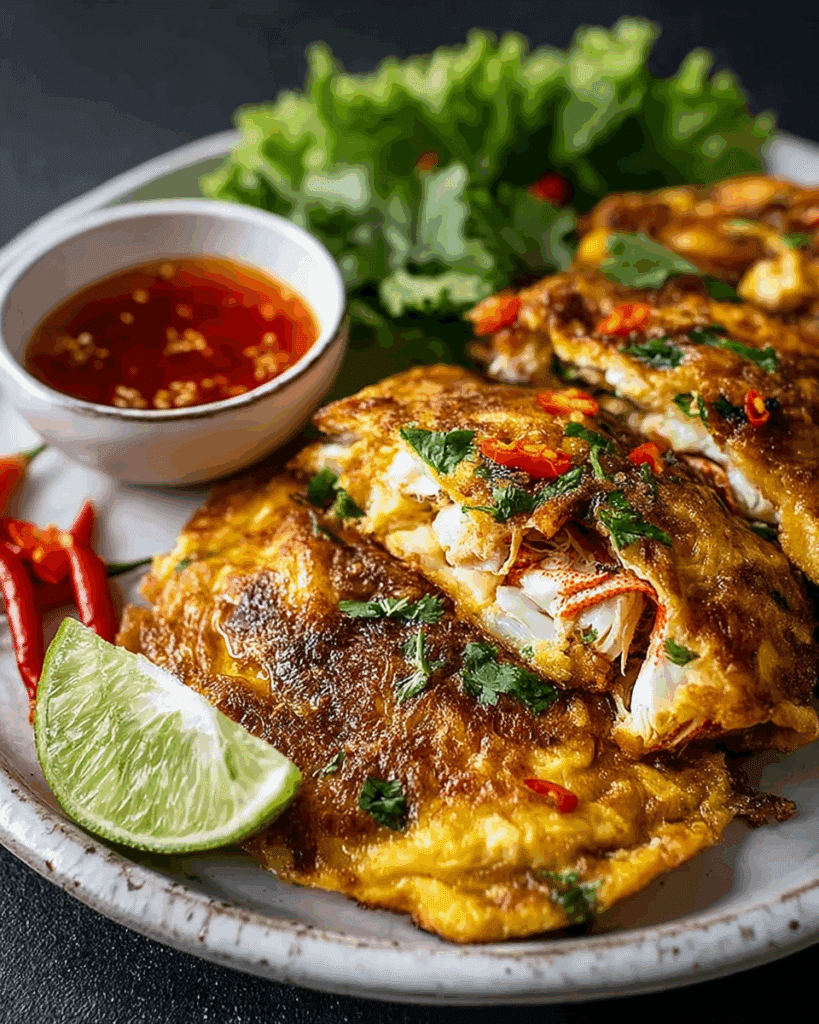
A lot of people ask if they can make a Thai Crab Omelette Recipe ahead of time. The honest answer is yes, you can, but with some notes. The Thai Crab Omelette Recipe is at its best when it is fresh from the hot oil, because that is when the edges are still puffy and crisp, and the center is still tender and juicy. That said, life is busy, and sometimes you want to prep a Thai Crab Omelette Recipe in advance for work lunches or for fast dinners.
Here is how to handle it. You can mix the eggs, Golden Mountain Sauce, minced garlic, and crab meat in advance, then store that raw mixture in an airtight container in the fridge for up to one day. When you are ready to cook, just give it a gentle stir and pour it into hot oil.
This gives you a freshly cooked Thai Crab Omelette Recipe with almost no prep time. I like this method because the crab stays tender, and the egg still puffs up. It keeps the spirit of a Thai Crab Omelette Recipe, which is all about high heat and instant comfort.
If you fully cook the Thai Crab Omelette Recipe and want to store leftovers, let the omelette cool completely first. Do not put a steaming hot Thai Crab Omelette Recipe directly into a container, or it will trap moisture, and the texture will turn soggy. Once cool, wrap the Thai Crab Omelette Recipe tightly or place it in an airtight box.
Keep it in the refrigerator for up to two days. When you want to reheat the Thai Crab Omelette Recipe, use a skillet on medium heat with just a tiny touch of oil. Warm each side until heated through. This helps the Thai Crab Omelette Recipe get some of its crisp edges back. The microwave also works, but it will make the Thai Crab Omelette Recipe softer, which some people do not mind if they plan to serve it over rice instead of eating it on its own.
Now, can you freeze a Thai Crab Omelette Recipe. You can, but with some caution. Eggs in a Thai Crab Omelette Recipe can change texture a little when frozen and thawed. The crab in the Thai Crab Omelette Recipe usually freezes better than the egg.
If you want to freeze your Thai Crab Omelette Recipe, the best way is to cook it fully, let it cool, cut it into portions, wrap each portion tightly, and freeze for up to one month. To reheat, let the Thai Crab Omelette Recipe thaw in the refrigerator overnight, then warm it in a skillet or in a hot oven for a few minutes. This brings back more of the original bite and aroma. Do not refreeze a Thai Crab Omelette Recipe once it has been thawed.
You can also meal prep rice and sauce to go with your Thai Crab Omelette Recipe. Cook jasmine rice in advance and keep it chilled in a sealed container. Make a small dipping sauce of fish sauce, chopped chilies, and lime juice. When you are ready to eat, reheat the Thai Crab Omelette Recipe, plate it over warm rice, spoon the sauce over the top, and garnish with coriander and green onion. In less than five minutes you will have a full bowl that tastes like a street side meal from Bangkok.
One more helpful tip. If you are planning to pack a Thai Crab Omelette Recipe for lunch, consider cutting the omelette into thick slices, and wrapping them in parchment. This makes it easier to eat on the go. The Thai Crab Omelette Recipe can be enjoyed warm, but it is also surprisingly good at room temperature. The crab stays sweet, and the egg stays rich and savory. Many people in Thailand eat dishes like a Thai Crab Omelette Recipe at room temperature, especially for a quick lunch, so you can absolutely do the same.
Making the Thai Crab Omelette Recipe ahead of time also works well for family gatherings or travel days, because you can cook a large Thai Crab Omelette Recipe, slice it into strips, and serve it like finger food. It is satisfying and keeps everyone full, and it does not require reheating right away. That is another reason the Thai Crab Omelette Recipe is loved so much. It is practical food, and it is comfort food, and it is beautiful on the plate, all at once.
When you plan ahead, store correctly, and reheat with care, you can enjoy a really good Thai Crab Omelette Recipe even on busy days.
Common Mistakes to Avoid
Even though this dish looks simple, there are a few details that can easily trip up new cooks. If you have ever ended up with a flat, greasy, or soggy omelette, do not worry. It happens to almost everyone at first. The good thing is that all of these problems have quick fixes once you know what went wrong.
The first mistake is using oil that is not hot enough. When the oil is just warm, the egg mixture soaks it up like a sponge, which makes the final omelette heavy and oily instead of airy and crisp. You want the oil to be very hot so that when the eggs hit it, they immediately bubble and rise. The fast reaction between the eggs and the oil is what gives that beautiful golden crust. If you are not sure whether the oil is ready, drop in a few drops of the egg mixture. If they rise right away and start to sizzle, you are good to go.
Another mistake is overmixing the crab or other fillings into the egg. The crab meat is delicate and can break into small pieces easily. When that happens, you lose the big, sweet bites that make this dish so satisfying. The goal is to combine gently, so the crab stays in chunks and the eggs stay fluffy.
A third mistake that people make is using too little oil. It might feel strange to fry an omelette in a lot of oil, especially if you are used to Western-style cooking, but this technique is what makes the texture special. The egg mixture should float slightly in the pan. This way, the outside crisps up evenly, while the inside stays soft and moist.
Timing is also a big factor. Cooking for too long dries out the inside, and not cooking long enough can leave it raw in the center. You need to watch carefully as it turns golden. Once the bottom is firm and crisp, you can either roll it or flip it, depending on the style you prefer. The more you cook this dish, the better you’ll get at knowing exactly when to pull it out.
Finally, many beginners make the mistake of letting the finished omelette sit too long before serving. This dish should be enjoyed immediately. Once it cools, it loses its texture and aroma. If you are cooking for several people, it’s better to fry them one at a time and serve each as soon as it’s ready, rather than making them all at once.
By keeping these common mistakes in mind, you’ll find yourself cooking with more confidence each time. The key is patience and heat control, which are both part of what make Thai-style cooking so satisfying to master.
Cultural or Historical Background
This dish has an interesting story that connects everyday home cooking to world-class cuisine. In Thailand, egg-based meals have long been considered a form of comfort food. Street vendors across Bangkok and other cities serve hot omelettes with rice as a quick, nourishing meal for busy people. It’s affordable, simple, and full of flavor, which is why it became such a beloved street staple.
The version that uses crab meat likely began in coastal areas where fresh seafood was abundant. Over time, this combination of eggs and crab became popular among both street vendors and home cooks. The balance of salty seasoning, sweet crab, and soft egg represents what Thai cooking does best: turning a few basic ingredients into something rich and satisfying.
In the last decade, this humble meal gained international fame thanks to a woman named Jay Fai. She is a Bangkok street vendor who earned a Michelin Star for her rolled crab omelette. Her dedication to quality and her fearless use of fresh ingredients made her a legend. She still cooks every dish by hand over a charcoal fire, wearing her iconic goggles to protect her eyes from the heat and oil. Tourists travel from all over the world just to taste her cooking. Through her, this simple omelette became a symbol of what makes Thai food so special. It’s not just about technique, it’s about care and authenticity.
Culturally, this dish represents Thai ingenuity. It shows how cooks adapt recipes to their surroundings and ingredients. It’s also an example of how street food can reflect a country’s identity as much as any fancy restaurant dish. In Thailand, food is a social experience, something that brings families, friends, and even strangers together at small tables in noisy markets. When you eat this omelette, you’re tasting more than eggs and crab. You’re tasting tradition, community, and history in every bite.
Many older Thai families still make this dish the same way their parents did, using simple woks, fresh crab, and seasoned oil. It’s not just breakfast or lunch—it’s a small connection to the past. Every cook puts their own touch on it, but the heart of the recipe never changes. That’s why it remains one of Thailand’s most cherished comfort foods.
Serving Suggestions
When it comes to serving, the beauty of this dish lies in its versatility. It can be part of a casual lunch, a quick dinner, or even a centerpiece in a larger Thai-style feast. The key is to pair it with sides that balance its rich, savory taste.
Traditionally, it’s served over a mound of hot jasmine rice. The soft rice absorbs the oil and seasoning from the omelette, making each bite feel comforting and complete. A small bowl of chili fish sauce on the side is a must. This simple sauce, made with fish sauce, chopped bird’s-eye chilies, and lime juice, cuts through the richness and adds a bright, spicy kick. Some people like to squeeze extra lime over the omelette itself for freshness.
For a lighter meal, you can serve the omelette alongside a crisp cucumber salad. The coolness of the cucumbers, combined with vinegar and sugar dressing, gives a refreshing contrast to the hot, crispy eggs. It’s also common to add sliced tomatoes or herbs for color and balance.
If you’re hosting a dinner or want to create a full Thai meal, you can pair the omelette with stir-fried morning glory, fried rice, or a bowl of tom yum soup. The combination of textures and flavors—soft eggs, spicy soup, and crisp greens feels like a complete journey through Thai cuisine. You can also include a small plate of fried shallots or garlic chips to sprinkle over the top, adding an extra crunch and aroma.
For a more Western-style presentation, you can slice the omelette into thick pieces and serve it as an appetizer. It goes surprisingly well with a light white wine or a cold Thai beer. The sweetness of crab pairs beautifully with both. In Thailand, many people enjoy this dish with a glass of iced tea or fresh coconut water, which balances the salty and rich flavors perfectly.
If you’re packing this for lunch, pair it with sticky rice and a small container of chili dipping sauce. It holds up well at room temperature and can be eaten without reheating. That’s part of why it’s a favorite among street food vendors. It’s easy to transport, satisfying, and always hits the spot.
The most important thing when serving is to keep it hot and crisp if you can. The contrast between the crunchy outer layer and the soft interior is what makes it special. Whether you’re serving it family-style in the center of the table or plating individual portions, garnish with coriander, green onions, or even a few slices of red chili for a pop of color.
In the end, this humble crab and egg dish fits anywhere from a breakfast counter in Bangkok to a weekend brunch table at home. It’s proof that simple food, cooked with care, can be both elegant and comforting.
Conclusion
This dish is more than just crab and eggs cooked in hot oil. It carries memory, technique, and identity. When I make it, I always think about street stalls lit by hanging bulbs, and the constant sound of woks clanging, and people sitting on tiny red stools with plates of rice and chili sauce. It feels alive, and it tastes like real life, not restaurant perfection.
The method is simple in theory, but there is skill in it. You whisk the eggs with care, you fold in the crab gently, and you pour into oil that is hot enough to sizzle the moment it touches the pan. Then you watch. You do not walk away and you do not rush. You guide it. You tilt, you fold, you flip, you press. You take it out when it is just right, and then you eat it while it is still singing from the heat. That is cooking with presence. That is why dishes like this taste so honest.
There is something else I love about it. You can make it humble or luxurious. You can use leftover crab and serve it with rice for a weekday meal, or you can load it with giant pieces of premium crab and bring it to the table like a celebration. You can cook a mild, silky version for kids, or a spicy version with bird’s-eye chilies for people who can handle heat.
You can keep it plain, or you can garnish it with herbs and bright lime. You can shape it into a rolled log, or leave it rustic and puffy. There is no one correct way to serve it, and I think that freedom invites people into the kitchen, instead of scaring them away.
On top of that, this dish represents the story of Thai cooking in a very real way. It shows how something that started as street food and everyday comfort can reach the global stage. When a sidewalk cook in Bangkok receives international praise for a dish like this, it reminds the world that flavor does not belong only to fine restaurants. It belongs to the people who cook with intention, and to the people who eat with joy.
So whether you are new to Thai flavors, or you have loved them for years, I hope you feel inspired to try this at home. It is fast, it is satisfying, and it honestly feels like a hug on a plate. Cook it for yourself. Cook it for someone you love. Share it at the table, with rice and a little bowl of chili sauce and lime wedges. That is the way it is meant to be eaten. Hot. Fragrant. Shared.
FAQ
Can I prepare it ahead of time for meal prep or lunch boxes
Mostly yes, with a few tips. You can mix the eggs, seasoning, garlic, and crab together ahead of time and keep that mixture sealed in the fridge for about one day. Then you just cook it when you are ready to eat. This gives you the freshness of a just-made omelette, without doing all the prep in the moment.
If you are storing leftovers that are already cooked, let them cool, wrap them tightly, and refrigerate for up to two days. When reheating, use a skillet on medium heat with just a touch of oil, instead of a microwave, if you want to bring back a little crisp on the outside. If you plan to pack it for lunch, you can eat it warm or at room temperature. It goes really well with rice and a small container of chili dipping sauce.
What should I serve on the side to make it feel like a full Thai style meal
The most common pairing is jasmine rice, chili and fish sauce, and maybe a small bowl of clear soup or a quick stir fried green. The rice helps balance the richness of the egg and crab. The chili sauce brings heat and salt, and the soup or vegetables add something light so the meal does not feel too heavy.
You can also add cucumber slices or fresh herbs like coriander on top for brightness and color. If you are serving guests, cutting the omelette into thick slices and arranging them on a platter makes it look special.
How do I make mine puff up like the street food version
Puff and crisp come from two things. Air in the eggs, and heat in the oil. First, you need to whisk your eggs very well before cooking. Do not just stir. Beat them until they are light and slightly foamy.
This traps air inside. Second, use enough oil so the mixture can float a little, and make sure that oil is very hot before you pour in the eggs. If the oil is too cool, the eggs will sink and turn greasy instead of puffing. Also, do not overcrowd the pan. Cook one at a time.
Can I use canned crab instead of fresh crab meat
Yes, you can. Fresh crab has the sweetest and cleanest flavor, which gives you the best result, but canned crab meat can absolutely work if that is what you have. If you are using canned meat, make sure you drain it well and pat it dry with a paper towel before mixing it with the eggs.
Too much moisture can keep the omelette from crisping in the pan. One more tip. Taste the crab first. Some canned brands are a little salty, so you may want to adjust the seasoning sauce in the egg mixture.

Thai Crab Omelette Recipe
- Prep Time: 10 minutes
- Cook Time: 5 minutes
- Total Time: 15 minutes
- Yield: 1 large omelette (serves 1–2) 1x
- Category: Main Course
- Method: Deep-Frying
- Cuisine: Thai
- Diet: Halal
Description
A fluffy and crispy Thai-style crab omelette made with fresh crab meat, eggs, and Thai seasoning sauce. Fried in hot oil for a golden, puffed texture and served with jasmine rice, chili sauce, and lime for an authentic Bangkok street food experience.
Ingredients
- 3 eggs
- 1 cup crab meat
- 1/2 tablespoon Golden Mountain Sauce
- 1 clove garlic, minced
- Oil for deep-frying, as needed
- 1 tablespoon coriander, chopped (optional, for topping)
- 1 green onion, chopped (optional, for topping)
Instructions
- Crack the eggs into a bowl and add the Golden Mountain Sauce. Whisk vigorously until the mixture is frothy and fully combined. This step introduces air to make the omelette light and fluffy.
- Gently stir in the crab meat and minced garlic. Mix lightly so the crab pieces remain intact.
- Heat a generous amount of oil in a non-stick skillet or wok over medium-high heat. The oil should be deep enough to allow the egg mixture to float slightly.
- When the oil is hot, slowly pour the egg and crab mixture into the center of the pan. Let it cook without stirring for a few seconds until the edges begin to crisp.
- For a rolled Bangkok-style version, use a spatula to lift one side and roll it toward the center, layering as you go. Continue cooking until golden and crispy, then drain on a paper towel.
- For a simpler version, cook the mixture as one large omelette, flipping once to ensure even cooking on both sides.
- Remove from the oil and drain well on paper towels to remove excess oil.
- Garnish with chopped coriander and green onions. Serve hot with steamed jasmine rice, chili sauce, and a squeeze of lime juice.
Notes
- Be sure to whisk the eggs thoroughly to incorporate air for extra fluffiness.
- If you can’t find Golden Mountain Sauce, substitute with light soy sauce and a few drops of fish sauce.
- Use fresh lump crab meat for the best flavor and texture.
- Oil temperature should be around 350°F (175°C) for proper puffing and crispiness.
- Drain the omelette on paper towels to prevent greasiness.
- Serve immediately to enjoy the best texture and aroma.
Nutrition
- Serving Size: 1 omelette
- Calories: 420
- Sugar: 1g
- Sodium: 780mg
- Fat: 31g
- Saturated Fat: 6g
- Unsaturated Fat: 23g
- Trans Fat: 0g
- Carbohydrates: 2g
- Fiber: 0g
- Protein: 32g
- Cholesterol: 310mg
Keywords: Thai Crab Omelette Recipe, authentic Thai omelette, Jay Fai crab omelette, Thai street food, Thai seafood omelette, Bangkok-style omelette, easy Thai crab dish

